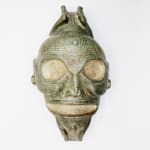Taíno 'Macorix' Head Trigolonito, AD 1300 - AD 1500
Greenstone
28 x 17.5 x 12 cm
11 x 6 7/8 x 4 3/4 in
11 x 6 7/8 x 4 3/4 in
CC.69
Further images
-
(View a larger image of thumbnail 1
)

-
(View a larger image of thumbnail 2
)

-
(View a larger image of thumbnail 3
)

-
(View a larger image of thumbnail 4
)

-
(View a larger image of thumbnail 5
)

-
(View a larger image of thumbnail 6
)

-
(View a larger image of thumbnail 7
)

-
(View a larger image of thumbnail 8
)

-
(View a larger image of thumbnail 9
)

-
(View a larger image of thumbnail 10
)

-
(View a larger image of thumbnail 11
)

-
(View a larger image of thumbnail 12
)

-
(View a larger image of thumbnail 13
)

When Columbus arrived in the New World in AD 1492, the islands he landed on had already been inhabited for some 2,000 years by the Taíno people, whose complex society...
When Columbus arrived in the New World in AD 1492, the islands he landed on had already been inhabited for some 2,000 years by the Taíno people, whose complex society impressed early Spanish conquerors. The Taíno probably descended from émigrés from Central America, who arrived in the Caribbean and supplanted the indigenous pre-pottery hunter-gatherers through disease and warfare. The Taíno were ruled by male chiefs, called caciques, who inherited their position through matrilineal succession. Below them were nobles (nitaínos) and commoners (naborias). Taíno women engaged in agriculture, while the men fished and hunted. They developed the use of poisoned arrowheads for hunting.
Taíno religion was centred around the worship of zemis, the ancestral spirits. Zemis were thought to live in a statue or figure housed in the round temples, the bohíos. Alongside zemis, in the form of animals or humans, the temples also housed the skulls of the ancestors. For the Taíno, the spiritual power of a human was housed in the head, and especially the face. By keeping the skulls of their ancestors, the Taíno retained some of their spiritual essence. But these skulls were not always very well-preserved, so later Taínos (AD 1000 – AD 1500) used stone skulls and heads as surrogates for the real thing. These heads are known as ‘Macorix’ heads, given that a large number of them were excavated from the site of San Pedro de Macorís in the Dominican Republic.
This ‘Macorix’ head depicts a human face which shares some features with a skull; it has large empty orbits, a short squat nose with open nostrils, and a gaping mouth turned up into a sinister smile. The head is decorated with traditional maze-like Taíno geometric designs; these occupy the forehead and chin of the piece, and the unusual protruding element from the crown of the skull. The figure has long ears, weighed down by circular stone earrings. From the top of the piece comes a large triangular protrusion, which includes a pair of limbs at right angles, recalling the profile of the trigonolito (three-pointed figure), a traditional form of Taíno art. While fearsome in appearance, it should be noted that this figure represented the ancestral line of the Taíno village, incorporating in these elements the essence of the Taíno culture and the history of the people.
Taíno religion was centred around the worship of zemis, the ancestral spirits. Zemis were thought to live in a statue or figure housed in the round temples, the bohíos. Alongside zemis, in the form of animals or humans, the temples also housed the skulls of the ancestors. For the Taíno, the spiritual power of a human was housed in the head, and especially the face. By keeping the skulls of their ancestors, the Taíno retained some of their spiritual essence. But these skulls were not always very well-preserved, so later Taínos (AD 1000 – AD 1500) used stone skulls and heads as surrogates for the real thing. These heads are known as ‘Macorix’ heads, given that a large number of them were excavated from the site of San Pedro de Macorís in the Dominican Republic.
This ‘Macorix’ head depicts a human face which shares some features with a skull; it has large empty orbits, a short squat nose with open nostrils, and a gaping mouth turned up into a sinister smile. The head is decorated with traditional maze-like Taíno geometric designs; these occupy the forehead and chin of the piece, and the unusual protruding element from the crown of the skull. The figure has long ears, weighed down by circular stone earrings. From the top of the piece comes a large triangular protrusion, which includes a pair of limbs at right angles, recalling the profile of the trigonolito (three-pointed figure), a traditional form of Taíno art. While fearsome in appearance, it should be noted that this figure represented the ancestral line of the Taíno village, incorporating in these elements the essence of the Taíno culture and the history of the people.












